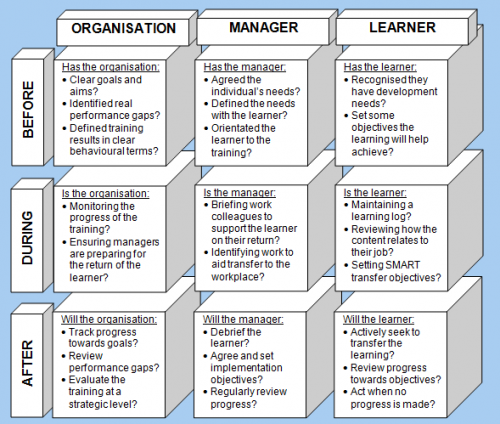In this two-part series, Garry Platt looks at how to ensure training and development remains a priority in your organisation.
Achieving organisational advantage or simply enhanced company performance has in past twenty five years often been driven by technological improvement and capital investment. The challenge that many organisations face at the moment is that despite having the technological advantage over competitors or a significant record of investment the competition is still catching up and closing the performance gap.
In the current climate it is also difficult to see how a wholly technological and capital investment strategy can be sustained. Strategic managers need to look again at their portfolio of resources and recognise that there is usually one area where significant changes at little to no cost would have an immense impact and that area is in the training and development of their people.
An organisation’s mission statement or annual report often contains the hackneyed phrase; ‘people are our most important asset’. It’s a cliché but also true. But it is also worth baring in mind that the opposite is also true. Investments can quickly become liabilities and to borrow a well worn phrase of the current times; toxic. Competitive advantage is impossible to sustain or achieve when the human resource within your organisation is not helping you to accomplish this.

The organisation may well have clear Strategic goals but if Tactical management fail to implement these correctly or simply don’t have the necessary knowledge and skills needed to follow through their progress will be significantly short of expectations. And similarly, Operational staff and managers if not clear about what is to be achieved and lacking the appropriate capabilities, once again failure is guaranteed, see diagram 1. Where however all three are strongly aligned, success is more likely to be achieved as all the key factors are pulling in the same direction. See diagram 2.

The whole purpose and intention of any training should be to equip the human resource with the necessary knowledge and skills to be aligned with the purpose and intention of the business. Frequently training doesn’t and because of this the competitive advantage of the organisation despite having a great business model and effective support systems is completely and utterly lost.
The reality in many organisations despite having a ‘training function’ is that the appreciation of how HR development should operate and how it works as a core function of the business is misunderstood. As a consequence the development of people is not driven by need and rarely if ever assessed for impact on the bottom line of the business. Indeed some argue that it is impossible to track the impact of development into the business. That is only the case where no true analysis of need has taken place or any plan of action for implementation made.
Training and development is not about improving people! That’s a bold statement and one that many training departments would argue to the death is incorrect. Training and development is about improving the business, first and foremost. Consequently the metric against which all requests for training should be assessed is how will it lead to the organisation achieving its goals and targets?
There is a pragmatic and effective strategy for helping organisations ensure that the developmental of its human resource is governed by sound principals. And that training and development is driven by ‘need’ that leads to competitive advantage and success.
The core of this approach can be summed up by a simple 3 square box model. We pose questions in three areas, they are;
- The Organisation
- The Manager of the learners’ and
- The Learner themselves
We then ask different questions at three different times; Before, During and After the developmental event. Those questions are outlined in the accompanying diagram, number 3. The answers to all these questions should be ‘Yes’. Hence the subtle subtitle; ‘The Man From HR, He Say Yyyyyeeeessss!’ If any answer is ‘No’ or a partial ‘No’ we should seek to introduce systems and mechanism which will change that situation. The result is a massive refinement in the design of events and a much greater transfer of learning to the workplace.

In the next instalment we look at complimentary processes for improving the performance and enhancement of people in the workplace looking at methods for ensuring the answers are Yes to the Before, During and After stages as outlined here.
Academically qualified to Masters Degree level in Education, Training and Development his work combines current research and study in Human Resource Development with a pragmatic and workable approach. Visit the EEF website for further details: www.eef.org.uk. Gary writes the Platts Puzzlings blog here on TrainingZone as well as managing the Transactional Analysis discussion group.
Photo credit: Jrives
In this two-part series, Garry Platt looks at how to ensure training and development remains a priority in your organisation.
Achieving organisational advantage or simply enhanced company performance has in past twenty five years often been driven by technological improvement and capital investment. The challenge that many organisations face at the moment is that despite having the technological advantage over competitors or a significant record of investment the competition is still catching up and closing the performance gap.
In the current climate it is also difficult to see how a wholly technological and capital investment strategy can be sustained. Strategic managers need to look again at their portfolio of resources and recognise that there is usually one area where significant changes at little to no cost would have an immense impact and that area is in the training and development of their people.
An organisation’s mission statement or annual report often contains the hackneyed phrase; ‘people are our most important asset’. It’s a cliché but also true. But it is also worth baring in mind that the opposite is also true. Investments can quickly become liabilities and to borrow a well worn phrase of the current times; toxic. Competitive advantage is impossible to sustain or achieve when the human resource within your organisation is not helping you to accomplish this.

The organisation may well have clear Strategic goals but if Tactical management fail to implement these correctly or simply don’t have the necessary knowledge and skills needed to follow through their progress will be significantly short of expectations. And similarly, Operational staff and managers if not clear about what is to be achieved and lacking the appropriate capabilities, once again failure is guaranteed, see diagram 1. Where however all three are strongly aligned, success is more likely to be achieved as all the key factors are pulling in the same direction. See diagram 2.

The whole purpose and intention of any training should be to equip the human resource with the necessary knowledge and skills to be aligned with the purpose and intention of the business. Frequently training doesn’t and because of this the competitive advantage of the organisation despite having a great business model and effective support systems is completely and utterly lost.
The reality in many organisations despite having a ‘training function’ is that the appreciation of how HR development should operate and how it works as a core function of the business is misunderstood. As a consequence the development of people is not driven by need and rarely if ever assessed for impact on the bottom line of the business. Indeed some argue that it is impossible to track the impact of development into the business. That is only the case where no true analysis of need has taken place or any plan of action for implementation made.
Training and development is not about improving people! That’s a bold statement and one that many training departments would argue to the death is incorrect. Training and development is about improving the business, first and foremost. Consequently the metric against which all requests for training should be assessed is how will it lead to the organisation achieving its goals and targets?
There is a pragmatic and effective strategy for helping organisations ensure that the developmental of its human resource is governed by sound principals. And that training and development is driven by ‘need’ that leads to competitive advantage and success.
The core of this approach can be summed up by a simple 3 square box model. We pose questions in three areas, they are;
- The Organisation
- The Manager of the learners’ and
- The Learner themselves
We then ask different questions at three different times; Before, During and After the developmental event. Those questions are outlined in the accompanying diagram, number 3. The answers to all these questions should be ‘Yes’. Hence the subtle subtitle; ‘The Man From HR, He Say Yyyyyeeeessss!’ If any answer is ‘No’ or a partial ‘No’ we should seek to introduce systems and mechanism which will change that situation. The result is a massive refinement in the design of events and a much greater transfer of learning to the workplace.

In the next instalment we look at complimentary processes for improving the performance and enhancement of people in the workplace looking at methods for ensuring the answers are Yes to the Before, During and After stages as outlined here.
Academically qualified to Masters Degree level in Education, Training and Development his work combines current research and study in Human Resource Development with a pragmatic and workable approach. Visit the EEF website for further details: www.eef.org.uk. Gary writes the Platts Puzzlings blog here on TrainingZone as well as managing the Transactional Analysis discussion group.
Photo credit: Jrives




